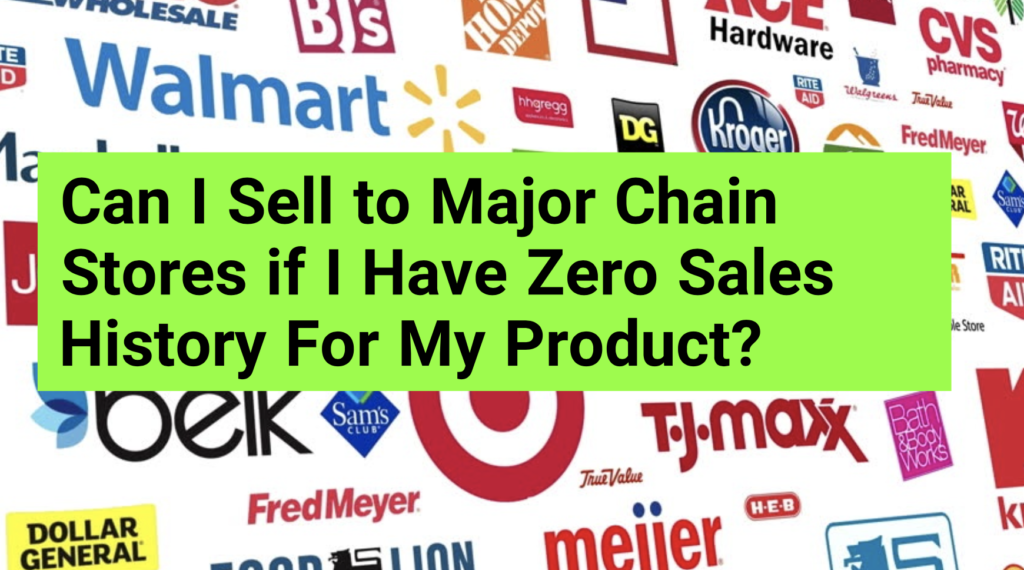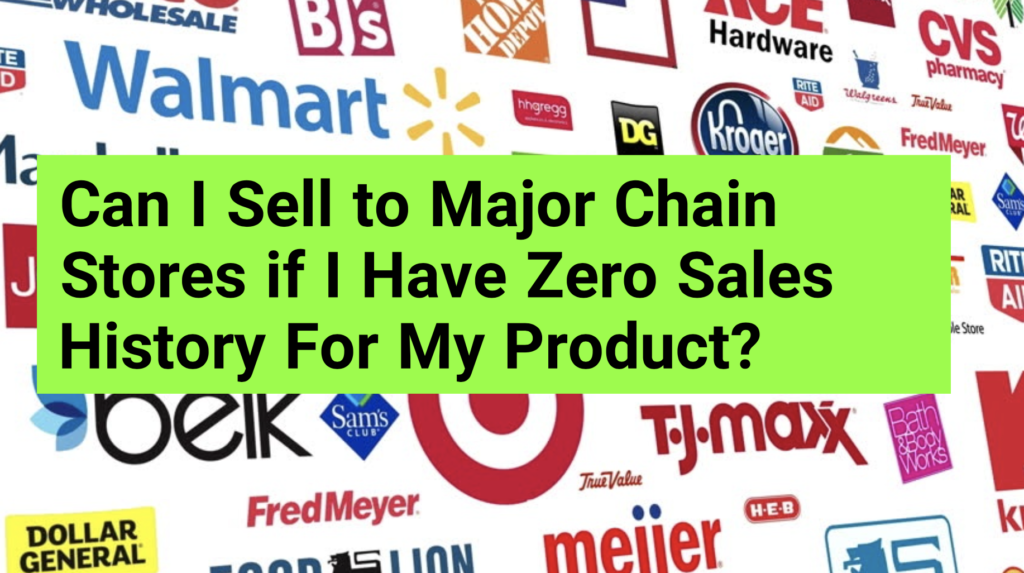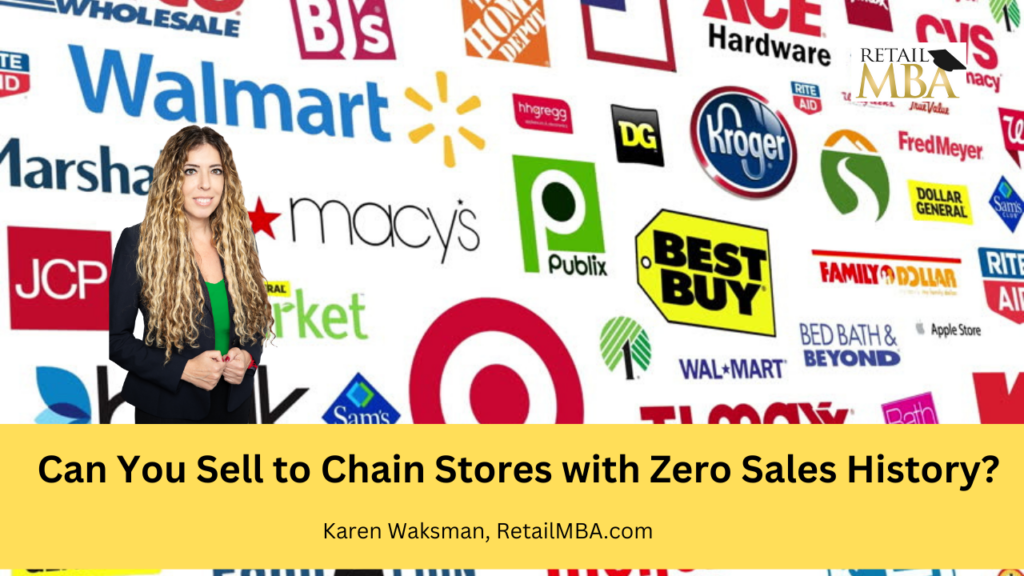How to Sell in Retail – What to Do If You Have Zero Sales History When Trying to Sell to Big Box Retail Chains?
Are you, in search of a product that’s ideal for chain stores like Walmart, Home Depot, CVS, Nordstrom or Kroger Grocery Store?
If thats the case then you’ll definitely be interested in our new training on “Selling in Retail. What to Do When Approaching Big Box Retail Chains with Zero Sales History!”
You can watch the training by clicking on the video above!
Karen Waksman, the founder of Retail MBA recently addressed a question regarding selling products to chain stores without any sales history. Karen has been assisting business owners worldwide in getting their products into chain stores and this particular question often arises during her workshops and classes.
During this training session, we will discuss the factors that need to be considered when introducing a brand product to chain stores. Additionally we will explore Karens advice on the effective approach for selling to these retail giants.
Is it Possible to Sell to Chain Stores Without Any Sales?
According to Karen’s perspective it is indeed possible to sell products to chain stores even if you have no sales history. She shares examples of clients who have directly entered chain stores without having sold their products as well, as others who initially started small and gradually grew their businesses before targeting chain stores.According to Karen the key factor lies in the mindset of the business owner. Some individuals are determined to secure a spot, in a chain store disregarding aspects. On the hand, there are cautious individuals who prefer starting small and gradually growing their business before targeting larger retailers.
Karen suggests that if you feel anxious about approaching stores it’s advisable to start by reaching out to smaller or mid sized stores. This approach allows you to establish and expand your business without committing to retailers.
Moreover Karen mentions that certain stores pose challenges when it comes to getting your products on their shelves. For instance Costco primarily purchases items by the pallet. Might be hesitant towards businesses lacking a sales history. However there are retailers who have dedicated divisions specifically meant for testing products actively seeking fresh and innovative offerings.
Karen has experience organizing events with major chain stores like Walmart and Whole Foods where she has assisted entrepreneurs in gaining exposure with retailers. During these events buyers tend to prefer businesses with sales records. Have also shown interest, in unique products that haven’t been sold elsewhere.
This is because they face competition and sometimes they struggle to achieve their desired outcomes.
Karen also mentions that certain Amazon sellers may find it difficult to envision selling to chain stores without establishing a presence on Amazon. However she believes that if she were introducing a product to the market she would directly approach the stores and aim for maximum profitability.
Tips for Selling in Retail
In summary. it is possible to sell to chain stores without any existing sales history. The approach you choose will depend on your mindset and preferences. Karen suggests that if you feel apprehensive about approaching the stores away it might be beneficial to start by reaching out to smaller or mid sized retailers.
Karen has participated in events with chain stores like Walmart and Whole Foods. Buyers have expressed a preference for businesses with sales records. They have also shown interest in products that haven’t been sold elsewhere.
If you’re interested, in learning more about how to approach, pitch and successfully sell your products to retailers Karen offers a 90 minute training webinar that you can sign up for

Transcript Outline for 'How to sell in Retail - What to Do if You Have Zero Retail Sales and Try to Pitch a Chain Store Buyer' Here:
If you’re a business owner who sells products you might be curious, about selling to chain stores without a sales history. Most retailers typically require evidence of success before considering a product. However according to Karen Waksman, the founder of Retail MBA it is indeed possible.
During her workshops and classes Waksman often receives inquiries about the feasibility of selling to chain stores without any sales record. In short the answer is yes – it’s possible. However the situation is more complex than a yes or no. There are factors to take into account.
Waksman explains that some individuals adopt a “go or go home” mentality and prefer approaching retailers right from the start. Others choose to begin with establishments and gradually expand their business before targeting players. There’s no right or wrong approach; it ultimately comes down to preference.
Costco Example
For those who wish to pursue chain stores it’s worth noting that certain retailers pose challenges, than others. For instance Costco typically purchases goods in bulk. May be less inclined to consider products from sellers. Some retailers have dedicated divisions specifically designed for testing items – they actively seek out innovation and fresh concepts.
During events Waksman has collaborated with retailers, like Walmart and Whole Foods witnessing buyers keen interest in previously unsold products. These retailers face competition. Constantly seek novel and captivating items. They possess an understanding of customer preferences. Are open to testing fresh products to meet those demands.
Hence if you have a brand product and aspire to secure deals with chain stores it is indeed possible. However it may require time to obtain that affirmation as certain retailers might reject your proposal more frequently than others. It is crucial to remember that a retailers decision to purchase your product is not solely based on the number of units sold or your sales history.
Getting Started
Ultimately whether you choose to pursue chain stores or start small and gradually expand your business depends on personal preference. If you firmly believe in the suitability of your product for chain stores and possess confidence in its success then by all means go ahead. However there is no shame, in starting small and gradually growing your business if that aligns better with your goals.If you’re interested, in discovering strategies for approaching, presenting and making sales to retailers Waksmans company called Retail MBA provides a 90 minute training webinar. This webinar encompasses all the information you need to grasp in order to persuade retailers to purchase your products and expand your business.
To sum up it is indeed possible to sell products to chain stores without a sales track record. While certain retailers may pose challenges than others there are opportunities available for new products. Ultimately it boils down to your preference and confidence, in the quality of your product. So take the leap. Witness where it leads you!
Step-by-step training on how to sell to major retailers
We explain exactly how to do that and how to get started today. I’ve taught tens of thousands of companies on how to get your products to the stores. And so we’re here to support you. Or please subscribe to our Youtube channel and or be on the lookout for additional training that we create.
We are here to expedite the process of making money with your physical products and that’s what we’re all about. Take a look at our advanced training, live events, certification programs and so much more.
In this training, I will discuss some of the things to think about when approaching a retailer to sell your products and become a vendor. Hope it helps! 🙂
Karen Waksman,
Retail MBA
Questions? Contact Us!
1-855-Retail-2 (Call or Text)
Email: info@retailmba.com
Retail MBA provides a step-by-step formula on How to Sell to Major Retailers, Online Retailers, Smaller Retailers, Catalogs and More. No Experience Required! These solutions continue to convert for clients year-over-year! These are Time-Tested and Proven Strategies that we utilize ourselves when going after stores! Everything we teach, we test. Want access to these formulas? ANY one of our programs and coaching systems gives you access to them now. With that said…
Here are 4 Easy Ways to Work with Us:
1) Free Training – If You Would Like to Join Our Next FREE Webinar Training Called “Retail Chain Store Secrets – How to Sell to Major Retail Chains. No Experience Required” Then Sign Up NOW To Learn All About Selling into Retail Chains By Clicking Here! https://www.retailmba.com
2) Masterclass Intensives – Want to Join our Next 4 Week Elite Retail MBA Masterclass Intensive? These Intensives Are EPIC for people who Love Fast Paced Learning – Homework, Retail Coaching, Developing Your Strategy, Buyers Contacts and More! These Events Are Held Every Quarter. Join us by Clicking Here: https://www.retailmbabrands.com/masterclass
3) Done-for-You Program – If You Want Karen Waksman and Her Team to Reach Out to Your Top Dream Retail Chains On Your Behalf – And You Have a Retail-Ready Product, Check Out our Epic Done-For-You Service by Clicking Here: https://www.retailmbabrands.com/done
4) In Person Events – If You Want to Learn LIVE and Meet Karen Waksman in Person at Our Next Retail Sellers LIVE Event with Other Like-Minded Individuals in Beautiful San Diego, CA!
We Would LOVE to Have You Join Us by Clicking Here: https://www.americasnextretailproduct.com
Thanks so much.
And…if you like this training, you will love these new short training sessions as well! Click on the links provided to watch and grow your consumer product business TODAY!



